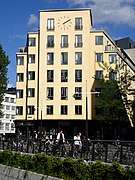Frederiksgade, Aarhus
Frederiksgade (lit. "Frederik's Street") is a street in the Indre By district in Aarhus, Denmark which runs north to south from Åboulevarden to Frederiks Allé. Frederiksgade is a major thoroughfare for pedestrians and cyclists and it connects Immervad to ARoS Aarhus Art Museum and the City Hall and Concert Hall parks. The street is fairly narrow and the architecture is primarily late 19th century to early 20th century.[1][2]
Frederiksgade | |
| Former name(s) | Brobjerggade |
|---|---|
| Length | 450 m (1,480 ft) |
| Location | Indre By, Aarhus, Denmark |
| Postal code | 8000 |
History
In medieval times, a street extended southwards from Vadestedet (The Ford) at Immervad across a steep hill south of the Aarhus river. In the Middle Age, a bridge was constructed at the ford and the street became known as Brobjerg ((lit. Bridge-hill)). The original housing along Brobjerg was constructed through the 1400s. In 1482, a sizeable Carmelite convent was built near the top of the hill, but following the Reformation in Denmark the convent fell on hard times and in 1541 it was demolished and the materials used for construction elsewhere.[3][4] Brobjerg was mostly settled by the 1600s, but during the occupation by Sweden during the Torstenson War, many buildings were torn down to get constructionmaterials for the defensive Skansepalæet.[5][6][7]
In 1824, Brobjerg was renamed Frederiksgade after the Danish king Frederik VI (1768-1839) who was involved in the restoration of the city gate Brobjerg Port. The king decided upon the design of the new city gate and in honor of his visit the gate was renamed Frederiksport and the street was named Frederiksgade.[8] Brobjerg had become an important thoroughfare in the city, with many large merchanthouses built here over the years.[9] However, in the 1800s it had fell into disrepair and it was decided to renovate it. The old wooden bridge over the river was replaced by one of granite and by 1854 the project was completed.[10][11]
Today, Frederiksgade has status of high-street with a commercial feel and many shops, boutiques, restaurants and bars. It is a major thoroughfare; the southern part is pedestrianized and the northern part is a cycle-street with priority for cyclists.
Notable buildings
The most notable building on Frederiksgade is the listed building Herskind's House (Købmand Herskind's Gård). The house was built in approximately 1850 and was listed on the Danish registry of protected buildings and places by the Danish Heritage Agency on 2 October 1970.[12] The building consists of the main building and two other wings; a half-timbered back building from 1726 and another smaller building facing the street. The buildings have been owned by a series of merchants who expanded the property at different times. In 1865 a connection was constructed between the main house and the south-wing and in 1858 a low north-wing was built.[13]
_01.jpg) A look down Frederiksgade
A look down Frederiksgade- Many pubs and bars. The Golden Lion Pub
 Several small backyards. The theatre of Teater Refleksion
Several small backyards. The theatre of Teater Refleksion- Bronze and water sculpture
- Stone sculpture
 Frederiksgade no. 1
Frederiksgade no. 1
References
- "Frederiksgade" (in Danish). Aarhus City Archives. Archived from the original on 2014-02-26. Retrieved 10 January 2017.
- "Frederiksgade" (in Danish). Aarhus Municipality through VisitAarhus. Archived from the original on 12 January 2017. Retrieved 10 January 2017.
- Sejr 1960, p. 59, line 4: "...rejstes i middelalderen et karmeliterkloster med tilhørende kirke... oprettet 1482."
- Sejr 1960, p. 60, line 1: "Efter reformationen blev klosteret vilkår vanskelige, og allerede 1541 var dets saga ude."
- Sejr 1960, p. 60, line 4: "Før svenskekrigene i det 17. århundrede har i hvert fald hele den venstre side af gaden været fuldt udbygget..."
- Sejr 1960, p. 60, line 8: "Men under den fjendtlige besættelse i 1640erne blev de yderste ejendomme i gaden nedrevet af svenskerne og brugt til at opbygge eller udvide den såkaldte >>Wallensteins skanse<<..."
- Sejr 1960, p. 60, line 10: "Efter den lange krigsperiode var næsten to tredjedele af byen >>spoleret<< og ikke mindst var det gået ud over Brobjerggaden."
- Sejr 1960, p. 64, line 10: "I 1824 fik Brobjerggade navneforandring til Frederiksgade. Årsagen var den at byporten, Brobjerg port skulle fornyes, og da Frederik VI var på besøg i byen, bad man ham udvælge den tegning, hvorefter porten skulle opføres, hvad han gjorde i landsfaderlig nåde..."
- Sejr 1960, p. 64, line 15: "Brobjerggade var langt tilbage i tiden en ret anselig gade med flere større gårde. Alligevel syntes den at have været i dårlig stand."
- Sejr 1960, p. 64, line 25: "Endnu i 1839 stod denne brolægningsproces på, bl.a. i forbindelse med opførelse af en ny kampestensbro over åen."
- Sejr 1960, p. 65, line 5: "At gaden virkelig var forbedret ses af en skildring af Århus fra 1854"
- "Købmand Herskinds Hus" (in Danish). Danish Heritage Agency. Archived from the original on 30 January 2016. Retrieved 28 January 2016.
- "Frederiksgade 79 Historisk" (in Danish). FO-byen. Archived from the original on 30 January 2016. Retrieved 28 January 2016.
- Publications
- Sejr, Emanuel (1960). Gamle Århusgader - Første samling. Århus Byhistoriske Udvalg. ISBN 87-504-0353-2.CS1 maint: ref=harv (link)
External links
| Wikimedia Commons has media related to Frederiksgade (Aarhus). |